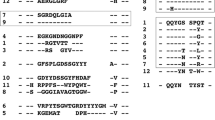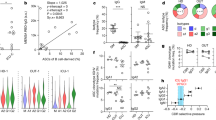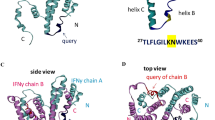Abstract
We demonstrate that in three cases of MC (two with immunocytoma), the IgM-RF+ component of their cryoprecipitated represents the circulating counterpart of the B-cell receptor (BCR) of the monoclonal overexpanded B-cell population. These IgMs were isolated and used to demonstrate a crossreactivity against both hepatitis C virus (HCV) NS3 antigen and the Fc portion of IgG. Epitopes were identified in a fraction of exemplary samples by using epitope excision approach (NS31250–1334 and IgG Fc345–355). The same phenomenon of crossreactivity has been shown to occur in vivo after immunization of a mouse with the NS31251−1270 peptide. To verify if the same reaction was also present in MC samples characterized by an oligo/polyclonal B-cell proliferation, IgM crossreactivity was tested in 14 additional samples. Five out of the 14 were reactive against HCV NS3 and 11 out of 14 were reactive against IgG-Fc peptide. The data support the role of HCV NS3 antigen in a subset of patients with MC, whereas the high frequency of the IgG-Fc epitope suggests that these B cells originate from precursors strongly selected for auto-IgG specificity. We suggest that engagement of specific BCRs by NS3 (or NS3-immunocomplex) antigen could explain the prevalence of IgM cryoglobulins in these patients
This is a preview of subscription content, access via your institution
Access options
Subscribe to this journal
Receive 12 print issues and online access
$259.00 per year
only $21.58 per issue
Buy this article
- Purchase on Springer Link
- Instant access to full article PDF
Prices may be subject to local taxes which are calculated during checkout





Similar content being viewed by others
References
Gisbert JP, Garcia-Buey L, Pajares JM, Moreno-Otero R . Prevalence of hepatitis C virus infection in B-cell non-Hodgkin's lymphoma: systematic review and meta-analysis. Gastroenterology 2003; 125: 1723–1732.
Mele A, Pulsoni A, Bianco E, Musto P, Szklo A, Sanpaolo MG et al. Hepatitis C virus and B-cell non-Hodgkin lymphomas: an Italian multicenter case–control study. Blood 2003; 102: 996–999.
Dammacco F, Sansonno D, Piccoli C, Racanelli V, D'Amore FP, Lauletta G . The lymphoid system in hepatitis C virus infection: autoimmunity, mixed cryoglobulinemia, and Overt B-cell malignancy. Semin Liver Dis 2000; 20: 143–157.
De Re V, De Vita S, Marzotto A, Rupolo M, Gloghini A, Pivetta B et al. Sequence analysis of the immunoglobulin antigen receptor of hepatitis C virus-associated non-Hodgkin lymphomas suggests that the malignant cells are derived from the rheumatoid factor-producing cells that occur mainly in type II cryoglobulinemia. Blood 2000; 96: 3578–3584.
De Re V, De Vita S, Marzotto A, Gloghini A, Pivetta B, Gasparotto D et al. Pre-malignant and malignant lymphoproliferations in an HCV-infected type II mixed cryoglobulinemic patient are sequential phases of an antigen-driven pathological process. Int J Cancer 2000; 87: 211–216.
Gasparotto D, De Re V, Boiocchi M . Hepatitis C virus, B-cell proliferation and lymphomas. Leuk Lymph 2002; 43: 747–751.
Brouet JC, Clauvel JP, Danon F, Klein M, Seligmann M . Biologic and clinical significance of cryoglobulins. A report of 86 cases. Am J Med 1974; 57: 775–788.
De Re V, De Vita S, Sansonno D, Gasparotto D, Simula MP, Tucci FA et al. Type II mixed cryoglobulinemia as an oligo rather than a mono B-cell disorder: evidence by GeneScan and Maldi-Tof analyses. Rheumatology 2006, January 6 (E-pub ahead of print).
Sansonno D, Lauletta GF, De Re V, Tucci FA, Gatti P, Racanelli V et al. Intrahepatic B cell clonal expansions and extrahepatic manifestations of chronic HCV infection. Eur J Immunol 2004; 34: 126–136.
Agnello V, Chung RT, Kaplan LM . A role for hepatitis C virus infection in type II cryoglobulinemia. N Engl J Med 1992; 327: 1490–1495.
Ferri C, Greco F, Longombardo G, Palla P, Moretti A, Marzo E et al. Antibodies to hepatitis C virus in patients with mixed cryoglobulinemia. Arthritis Rheum 1991; 34: 1606–1610.
Hussell T, Isaacson PG, Crabtree JE, Spencer J . The response of cells from low-grade B-cell gastric lymphomas of mucosa-associated lymphoid tissue to Helicobacter pylori. Lancet 1993; 342: 571–574.
De Re V, De Vita S, Gasparotto D, Marzotto A, Carbone A, Ferraccioli G et al. Salivary gland B cell lymphoproliferative disorders in Sjogren's syndrome present a restricted use of antigen receptor gene segments similar to those used by hepatitis C virus-associated non-Hodgkins's lymphomas. Eur J Immunol 2002; 32: 903–910.
Bende RJ, Aarts WM, Riedl RG, de Jong D, Pals ST, van Noesel CJ . Among B cell non-Hodgkin's lymphomas, MALT lymphomas express a unique antibody repertoire with frequent rheumatoid factor reactivity. J Exp Med 2005; 201: 1229–1241.
Kelaidi C, Rollot F, Park S, Tulliez M, Christoforov B, Calmus Y et al. Response to antiviral treatment in hepatitis C virus-associated marginal zone lymphomas. Leukemia 2004; 18: 1711–1716.
Levine AM, Shimodaira S, Lai MM . Treatment of HCV-related mantle-cell lymphoma with ribavirin and pegylated interferon Alfa. N Engl J Med 2003; 349: 2078–2079.
Emens LA, Sulkowski MS . Regression of splenic lymphoma after treatment of hepatitis C virus infection. N Engl J Med 2002; 347: 2168–2170.
Mazzaro C, Little D, Pozzato G . Regression of splenic lymphoma after treatment of hepatitis C virus infection. N Engl J Med 2002; 347: 2168–2170.
Hermine O, Lefrere F, Bronowicki JP, Mariette X, Jondeau K, Eclache-Saudreau V et al. Regression of splenic lymphoma with villous lymphocytes after treatment of hepatitis C virus infection. N Engl J Med 2002; 347: 89–94.
Guo JQ, You SY, Li L, Zhang YZ, Huang JN, Zhang CY . Construction and high-level expression of a single-chain Fv antibody fragment specific for acidic isoferritin in Escherichia coli. J Biotechnol 2003; 102: 177–189.
van Dongen JJ, Langerak AW, Bruggemann M, Evans PA, Hummel M, Lavender FL et al. Design and standardization of PCR primers and protocols for detection of clonal immunoglobulin and T-cell receptor gene recombinations in suspect lymphoproliferations: report of the BIOMED-2 concerted action BMH4-CT98-3936. Leukemia 2003; 17: 2257–2317.
Corper AL, Sohi MK, Bonagura VR, Steinitz M, Jefferis R, Feinstein A et al. Structure of human IgM rheumatoid factor Fab bound to its autoantigen IgG FC reveals a novel topology of antibody-antigen interaction. Nat Struct Biol 1997; 4: 374–381.
Jefferis R, Mageed RA . The specificity and reactivity of rheumatoid factors with human IgG. Monogr Allergy 1989; 26: 45–60.
Parker CE, Papac DI, Trojak SK, Tomer KB . Epitope mapping by mass spectrometry: determination of an epitope on HIV-1 IIIB p26 recognized by a monoclonal antibody. J Immunol 1996; 157: 198–206.
Armitage P, Berry G . Statistical Methods in Medical Research. 2nd edn, Blackwell Sc. Publications: Oxford, 1987, 93–140.
Young CL, Adamson TC, Vaughan JH, Fox RI . Immunohistologic characterization of synovial membrane lymphocytes in rheumatoid arthritis. Arthritis Rheum 1984; 27: 41–44.
Knecht H, Saremaslani P, Hedinger C . Immunohistological findings in Hashimoto's thyroiditis, focal lymphocytic thyroiditis and thyroiditis de Quervain: comparative study. Virchows Arch Abt A Pathol Anat 1981; 393: 215–220.
Monteverde A, Ballare M, Bertoncelli MC, Zigrossi P, Sabattini E, Poggi S et al. Lymphoproliferation in type II mixed cryoglobulinemia. Clin Exp Rheumatol 1995; 13: 141–147.
Monti G, Pioltelli P, Saccardo F, Campanini M, Candela M, Cavallero G et al. Incidence and characteristics of non-Hodgkin lymphomas in a multicenter case file of patients with hepatitis C virus-related symptomatic mixed cryoglobulinemias. Arch Int Med 2005; 165: 101–105.
Quinn ER, Chan CH, Hadlock KG, Foung SK, Flint M, Levy S . The B-cell receptor of a hepatitis C virus (HCV)-associated non-Hodgkin lymphoma binds the viral E2 envelope protein, implicating HCV in lymphomagenesis. Blood 2001; 98: 3745–3749.
Alexopoulou A, Dourakis SP . Genetic heterogeneity of hepatitis viruses and its clinical significance. Curr Drug Targets Inflamm Allergy 2005; 4: 47–55.
Ou-Yang P, Chiang BL, Hwang LH, Chen YG, Yang PM, Chi WK et al. Characterization of monoclonal antibodies against hepatitis C virus nonstructural protein 3: different antigenic determinants from human B cells. J Med Virol 1999; 57: 345–350.
Puoti M, Zonaro A, Ravaggi A, Marin MG, Castelnuovo F, Cariani E . Hepatitis C virus RNA and antibody response in the clinical course of acute hepatitis C virus infection. Hepatology 1992; 16: 877–881.
Sallberg M, Zhang ZX, Chen M, Jin L, Birkett A, Peterson DL et al. Immunogenicity and antigenicity of the ATPase/helicase domain of the hepatitis C virus non-structural 3 protein. J Gen Virol 1996; 77: 2721–2728.
Takaki A, Wiese M, Maertens G, Depla E, Seifert U, Liebetrau A et al. Cellular immune responses persist and humoral responses decrease two decades after recovery from a single-source outbreak of hepatitis C. Nat Med 2000; 6: 578–582.
Day CL, Lauer GM, Robbins GK, McGovern B, Wurcel AG, Gandhi RT et al. Broad specificity of virus-specific CD4+ T-helper-cell responses in resolved hepatitis C virus infection. J Virol 2002; 76: 12584–12595.
Diepolder HM, Zachoval R, Hoffmann RM, Wierenga EA, Santantonio T, Jung MC et al. Possible mechanism involving T-lymphocyte response to non-structural protein 3 in viral clearance in acute hepatitis C virus infection. Lancet 1995; 346: 1006–1007.
Oppliger IR, Nardella FA, Stone GC, Mannik M . Human rheumatoid factors bear the internal image of the Fc binding region of staphylococcal protein A. J Exp Med 1987; 166: 702–710.
Nardella FA, Oppliger IR, Stone GC, Sasso EH, Mannik M, Sjoquist J et al. Fc epitopes for human rheumatoid factors and the relationships of rheumatoid factors to the Fc binding proteins of microorganisms. Scand J Rheumatol Suppl 1988; 75: 190–198.
Stone GC, Sjobring U, Bjorck L, Sjoquist J, Barber CV, Nardella FA . The Fc binding site for streptococcal protein G is in the C gamma 2-C gamma 3 interface region of IgG and is related to the sites that bind staphylococcal protein A and human rheumatoid factors. J Immunol 1989; 143: 565–570.
Dolganiuc A, Oak S, Kodys K, Golenbock DT, Finberg RW, Kurt-Jones E et al. Hepatitis C core and nonstructural 3 proteins trigger toll-like receptor 2-mediated pathways and inflammatory activation. Gastroenterology 2004; 127: 1513–1524.
Leadbetter EA, Rifkin IR, Hohlbaum AM, Beaudette BC, Shlomchik MJ, Marshak-Rothstein A . Chromatin-IgG complexes activate B cells by dual engagement of IgM and Toll-like receptors. Nature 2002; 416: 603–607.
Rifkin IR, Leadbetter EA, Busconi L, Viglianti G, Marshak-Rothstein A . Toll-like receptors, endogenous ligands, and systemic autoimmune disease. Immunol Rev 2005; 204: 27–42.
Acknowledgements
We thank Alessandra Marzotto for technical help and Luigina Mei for editorial assistence. Source of support: this study was supported by ‘Associazione Italiana per la Ricerca sul Cancro’ (AIRC), by grants from the Fondo Sanitario Nazionale-Ministero della salute-FSN 2003, Fondo regionale Friuli-Venezia-Giulia project LR 11/2003 and by Società Italiana di Reumatologia.
Author information
Authors and Affiliations
Corresponding author
Additional information
Supplementary Information accompanies the paper on the Leukemia website (http://www.nature.com/leu)
Supplementary information
Rights and permissions
About this article
Cite this article
De Re, V., Sansonno, D., Simula, M. et al. HCV-NS3 and IgG-Fc crossreactive IgM in patients with type II mixed cryoglobulinemia and B-cell clonal proliferations. Leukemia 20, 1145–1154 (2006). https://doi.org/10.1038/sj.leu.2404201
Received:
Revised:
Accepted:
Published:
Issue Date:
DOI: https://doi.org/10.1038/sj.leu.2404201
Keywords
This article is cited by
-
Delineation of autoantibody repertoire through differential proteogenomics in hepatitis C virus-induced cryoglobulinemia
Scientific Reports (2016)
-
The expanding spectrum of HCV-related cryoglobulinemic vasculitis: a narrative review
Clinical and Experimental Medicine (2016)
-
Assessment of total hepatitis C virus (HCV) core protein in HCV-related mixed cryoglobulinemia
Arthritis Research & Therapy (2014)
-
Hepatitis C Virus-Mediated Modulation of Cellular Immunity
Archivum Immunologiae et Therapiae Experimentalis (2012)



